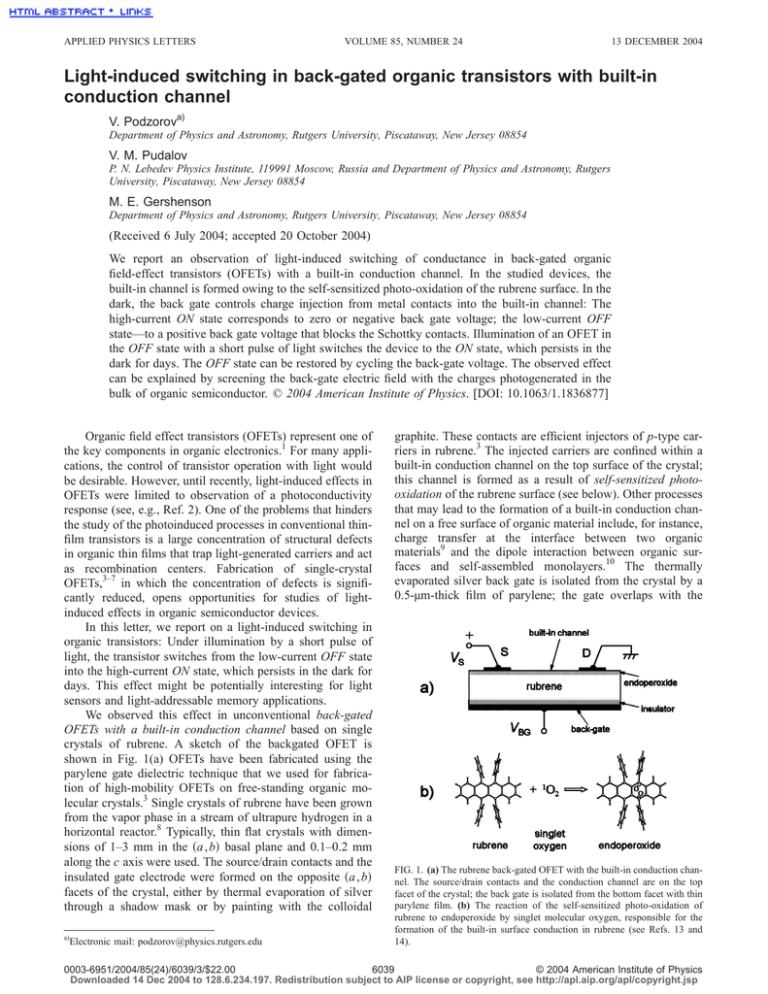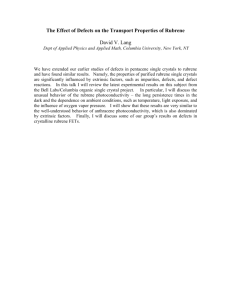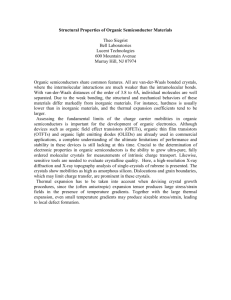Light-induced switching in back-gated organic transistors with built
advertisement

APPLIED PHYSICS LETTERS VOLUME 85, NUMBER 24 13 DECEMBER 2004 Light-induced switching in back-gated organic transistors with built-in conduction channel V. Podzorova) Department of Physics and Astronomy, Rutgers University, Piscataway, New Jersey 08854 V. M. Pudalov P. N. Lebedev Physics Institute, 119991 Moscow, Russia and Department of Physics and Astronomy, Rutgers University, Piscataway, New Jersey 08854 M. E. Gershenson Department of Physics and Astronomy, Rutgers University, Piscataway, New Jersey 08854 (Received 6 July 2004; accepted 20 October 2004) We report an observation of light-induced switching of conductance in back-gated organic field-effect transistors (OFETs) with a built-in conduction channel. In the studied devices, the built-in channel is formed owing to the self-sensitized photo-oxidation of the rubrene surface. In the dark, the back gate controls charge injection from metal contacts into the built-in channel: The high-current ON state corresponds to zero or negative back gate voltage; the low-current OFF state—to a positive back gate voltage that blocks the Schottky contacts. Illumination of an OFET in the OFF state with a short pulse of light switches the device to the ON state, which persists in the dark for days. The OFF state can be restored by cycling the back-gate voltage. The observed effect can be explained by screening the back-gate electric field with the charges photogenerated in the bulk of organic semiconductor. © 2004 American Institute of Physics. [DOI: 10.1063/1.1836877] Organic field effect transistors (OFETs) represent one of the key components in organic electronics.1 For many applications, the control of transistor operation with light would be desirable. However, until recently, light-induced effects in OFETs were limited to observation of a photoconductivity response (see, e.g., Ref. 2). One of the problems that hinders the study of the photoinduced processes in conventional thinfilm transistors is a large concentration of structural defects in organic thin films that trap light-generated carriers and act as recombination centers. Fabrication of single-crystal OFETs,3–7 in which the concentration of defects is significantly reduced, opens opportunities for studies of lightinduced effects in organic semiconductor devices. In this letter, we report on a light-induced switching in organic transistors: Under illumination by a short pulse of light, the transistor switches from the low-current OFF state into the high-current ON state, which persists in the dark for days. This effect might be potentially interesting for light sensors and light-addressable memory applications. We observed this effect in unconventional back-gated OFETs with a built-in conduction channel based on single crystals of rubrene. A sketch of the backgated OFET is shown in Fig. 1(a) OFETs have been fabricated using the parylene gate dielectric technique that we used for fabrication of high-mobility OFETs on free-standing organic molecular crystals.3 Single crystals of rubrene have been grown from the vapor phase in a stream of ultrapure hydrogen in a horizontal reactor.8 Typically, thin flat crystals with dimensions of 1–3 mm in the 共a , b兲 basal plane and 0.1–0.2 mm along the c axis were used. The source/drain contacts and the insulated gate electrode were formed on the opposite 共a , b兲 facets of the crystal, either by thermal evaporation of silver through a shadow mask or by painting with the colloidal a) Electronic mail: podzorov@physics.rutgers.edu graphite. These contacts are efficient injectors of p-type carriers in rubrene.3 The injected carriers are confined within a built-in conduction channel on the top surface of the crystal; this channel is formed as a result of self-sensitized photooxidation of the rubrene surface (see below). Other processes that may lead to the formation of a built-in conduction channel on a free surface of organic material include, for instance, charge transfer at the interface between two organic materials9 and the dipole interaction between organic surfaces and self-assembled monolayers.10 The thermally evaporated silver back gate is isolated from the crystal by a 0.5-µm-thick film of parylene; the gate overlaps with the FIG. 1. (a) The rubrene back-gated OFET with the built-in conduction channel. The source/drain contacts and the conduction channel are on the top facet of the crystal; the back gate is isolated from the bottom facet with thin parylene film. (b) The reaction of the self-sensitized photo-oxidation of rubrene to endoperoxide by singlet molecular oxygen, responsible for the formation of the built-in surface conduction in rubrene (see Refs. 13 and 14). 0003-6951/2004/85(24)/6039/3/$22.00 6039 © 2004 American Institute of Physics Downloaded 14 Dec 2004 to 128.6.234.197. Redistribution subject to AIP license or copyright, see http://apl.aip.org/apl/copyright.jsp 6040 Appl. Phys. Lett., Vol. 85, No. 24, 13 December 2004 FIG. 2. The dependence of the source–drain current, ISD, on the back-gate voltage, VBG, measured at fixed Vs = + 10 V in the dark. The sketch of the back-gated device is shown in the inset. The crystal thickness h = 0.2 mm, L ⬃ W ⬃ 1 mm, parylene thickness d = 0.5 m Ⰶ h. At VBG ⬎ 300 V, the current measurements are limited by the sensitivity of our experimental setup 共⬃10−14 A兲. entire area of the channel and contact pads. All of the measurements described below have been performed at room temperature. Operation of the back-gated rubrene OFET is illustrated in Fig. 2. Application of a negative voltage to the back gate 共VBG兲, separated from the p-type channel by ⬃0.1–0.2 mm thick crystal, does not significantly affect the high-current ON state. However, application of a positive VBG in the dark reduces source–drain current 共ISD兲 by many orders of magnitude by blocking carrier injection from the source contact into the conduction channel. The back gate controls the resistance of the Schottky contacts without directly affecting the band “bending” at the top surface of semiconductor, which is determined solely by the surface-restricted interaction. At a sufficiently large positive VBG, device current in the dark becomes very small 共⬃10−14 A兲—much lower than the OFF current in the conventional depleted front-gated OFETs.3 This is due to the fact that the back-gate electric field blocks the charge injection over the entire area of the contacts, whereas the front gate affects the injection only along the perimeter of the contacts. In the dark, the OFF state of our devices is stable: It lasts while positive VBG is maintained. The ON state can be restored by zeroing the back-gate voltage. Despite the apparent similarity of the geometry of our back-gated OFET with the conventional “top-contact” organic transistor,1 the operation principle of our device is different. In the studied devices, the built-in conduction channel forms at the semiconductor’s surface opposite to the gate electrode surface.11 The channel is separated from the gate not only by a layer of dielectric, but also by an optically active organic semiconductor—this feature of the back-gated OFETs is crucial for observation of the unusual optical response. A relatively large conductivity of the device in the ON sate 共VBG 艋 0兲 is due to the built-in surface conduction channel.12 We argue that the surface-restricted oxidation of rubrene13,14 that occurs under illumination of as-grown crystals with visible light in air, is responsible for this effect. Rubrene is oxidized by the singlet oxygen 1O2 [the first excited state of the molecular oxygen, see Fig. 1(b)], which is produced in the process of photosensitization—the energy Podzorov, Pudalov, and Gershenson FIG. 3. The effect of a light pulse on the conductivity of the depleted back-gated rubrene OFETs. The source–drain current, ISD, was measured at Vs = + 10 V. The initial low-current OFF state in the dark was prepared by “blocking” the Schottky contacts by a large positive VBG = + 300 V, which was fixed for the whole duration of this measurement. Illumination of the front surface results in factor-of-103 increase of ISD that persists after the light is off. transfer from a photoexited aromatic hydrocarbon with a long-lived triplet state (the sensitizer) to the molecular oxygen in the ground state 共3O2兲.14 Rubrene is one of the most efficient organic sensitizers.15 As a result of the selfsensitized photo-oxidation, a layer of endoperoxide grows at the rubrene surface exposed to air under illumination with ambient light [Fig. 1(b)]. Contrary to the oxidation of disordered organic films, oxidation of monolithic single crystals is restricted to a very thin surface layer.13 A thin and uniform surface dipole layer created by the endoperoxide results in a violation of the flat-band condition at the surface and the formation of a potential well filled with charge carriers injected from the contacts. Due to the built-in channel, surface conductivity of as-grown free-standing rubrene crystals is greater by a factor of ⬃103–106 than that of anthracene, tetracene, pentacene, and other aromatic crystalline compounds that are not efficient sensitizers.13,15 The back-gated OFETs with a built-in conduction channel demonstrate an intriguing photoresponse. Illumination of the depleted devices in the OFF state (at large positive VBG) with a short pulse of light leads to switching the device into the ON state (Fig. 3).16 Interestingly, after the light pulse ends, the device remains in the ON state for days, despite the fact that positive VBG is maintained. The OFF state can be restored by zeroing the back-gate voltage and reapplying a positive VBG in the dark. The switching effect does not depend on the source–drain voltage 共Vs兲: Turning Vs off and restoring it in either states does not alter the state of the transistor. The ON state current varies linearly with Vs. We propose the following explanation for the observed effect. The n- and p-type carriers, photogenerated in the bulk of the organic crystal, are spatially separated in the electric field created by the back gate. The n-type carriers migrate through the bulk toward the back gate (at VBG ⬎ 0), whereas the p-type carriers are repelled toward the conducting channel and escape through the contacts. The n-type carriers, accumulated near the insulated gate interface, are unable to escape from the sample because the leakage current through the insulating layer of parylene is negligibly small. They form a negative space charge that screens the back-gate electric field even after the light is off. Screening the depleting gate field “opens” the Schottky contacts and initiates current flow through the built-in channel on the top surface of the crystal. When the positive VBG is removed, n-type carriers Downloaded 14 Dec 2004 to 128.6.234.197. Redistribution subject to AIP license or copyright, see http://apl.aip.org/apl/copyright.jsp Appl. Phys. Lett., Vol. 85, No. 24, 13 December 2004 escape through the contacts, and another application of the positive VBG in the dark switches the device to the OFF state again. The response of the devices to light pulses, presumably limited by the diffusion time of nonequilibrium charge carriers in the bulk, is fast owing to the high mobility of carriers in the single crystals of rubrene.3 We did not observe any hysteresis in the device operation, which is consistent with a low density of charge traps in high-quality rubrene crystals. Note that the observed phenomenon is different from a slow relaxation of light-induced conductivity in the polymer field-effect transistors (FETs),2 which was attributed to the persistent photoconductivity. In the case of the studied rubrene FETs with a typical mobility of charge carriers ⬃10 cm2 / V s, the mobile nonequilibrium carriers would be driven out of the conduction channel by a typical source– drain electric field ⬃100 V / cm within 10−4 s. The possibility to observe the described effect in thinfilm organic devices depends on the film crystallinity and the film thickness. The grain boundaries in polycrystalline films may significantly reduce the conductivity of the built-in channel. Therefore, we expect that such an effect would be possible to observe in films with a high degree of crystallinity, or in devices with small channel dimensions that allow probing a single grain or a few grains. The film thickness in such devices should not be too small. Otherwise, application of the source–drain voltage between the contacts on the top surface of the device will electrostatically induce negative charges at the gate electrode and, therefore, will result in conventional field-effect conduction along the bottom surface of the organic film (Fig. 1).3 In the latter case, both the conventional field-effect current induced at the bottom surface and the built-in current on the top surface of the semiconductor will be measured in the same circuit. Since conventional field-effect current is typically larger, the built-in conductivity will be hard to detect. To summarize, we fabricated and characterized the backgated organic transistors with a built-in conduction channel formed due to a charge-transfer reaction at the organic surface. The back gate modulates the current in these devices by blocking the injection of p-type carriers from the contacts into the built-in channel. We have observed switching of these devices from the OFF state into the persistent ON state induced by a short pulse of light. The effect is attributed to screening of the back-gate electric field by nonequilibrium carriers photogenerated in the bulk and accumulated at the surface facing the back-gate electrode. The OFF state can be restored by cycling the back-gate voltage in the dark. The absence of grain boundaries and the well-ordered organic surfaces of single-crystal OFETs facilitate observation and interpretation of this effect, as well as, more broadly, the study of surface restricted interactions and their effect on the Podzorov, Pudalov, and Gershenson 6041 electronic properties of organic electronic devices. The selflatching character of the observed effect opens an opportunity for using organic field-effect devices with a built-in conduction channel as light-addressable memory elements and light sensors. This work has been supported by the NSF Grant Nos. DMR-0405208 and ECS-0437932, and Russian grants from RFBR and Presidential program of the support of leading scientific schools. 1 See, e.g., R. J. Chesterfield, J. C. McKeen, C. R. Newman, C. D. Frisbie, P. C. Ewbank, K. R. Mann, and L. L. Miller, J. Appl. Phys. 95, 6396 (2004); H. Klauk, M. Halik, U. Zschieschang, G. Schmid, W. Radlik, and W. Weber, ibid. 92, 5259 (2002); S. F. Nelson, Y.-Y. Lin, D. J. Gundlach, and T. N. Jackson, Appl. Phys. Lett. 72, 1854 (1998), and references therein. 2 K. S. Narayan and N. Kumar, Appl. Phys. Lett. 79, 1891 (2001); S. Dutta and K. S. Narayan, Phys. Rev. B 68, 125208 (2003). 3 V. Podzorov, V. M. Pudalov, and M. E. Gershenson, Appl. Phys. Lett. 82, 1739 (2003); V. Podzorov, S. E. Sysoev, E. Loginova, V. M. Pudalov, and M. E. Gershenson, ibid. 83, 3504 (2003). 4 R. W. I. De Boer, T. M. Klapwijk, and A. F. Morpurgo Appl. Phys. Lett. 83, 4345 (2003). 5 J. Takeya, C. Goldmann, S. Haas, K. P. Pernstich, B. Ketterer, and B. Batlogg, J. Appl. Phys. 94, 5800 (2003). 6 V. Y. Butko, X. Chi, D. V. Lang, and A. P. Ramirez, Appl. Phys. Lett. 83, 4773 (2003). 7 R. W. I. de Boer, M. E. Gershenson, A. F. Morpurgo, and V. Podzorov, Phys. Status Solidi A 201, 1302 (2004). 8 C. Kloc, P. G. Simpkins, T. Siegrist, and R. A. Laudise, J. Cryst. Growth 182, 416 (1997). 9 V. M. Agranovich, Phys. Scr., T 49, 699 (1993); A. A. Zakhidov and K. Yoshino, Synth. Met. 64, 155 (1996). 10 S. Kobayashi, T. Nishikawa, T. Takenobu, S. Mori, T. Shimoda, T. Mitani, H. Shimotani, N. Yoshimoto, S. Ogawa, and Y. Iwasa, Nat. Mater. 3, 317 (2004). 11 In the studied devices, the front gate is absent—thus, the conduction channel cannot be electrostatically induced at positive Vs due to the mirror charge effect. 12 The surface character of this conductivity can be demonstrated using the front-gate electrode mechanically laminated against the free-standing rubrene crystals with contacts. We used a 2-µm-thick aluminized Mylar film that served as a gate, and we measured ISD before and after attaching it to the surface of the crystal. Drastic reduction of the conductivity with application of a positive front-gate voltage signifies the depletion of the built-in channel and suggests that the built-in conduction is restricted to the surface of the crystal. 13 V. Ramamurthy and K. Venkatesan, Chem. Rev. (Washington, D.C.) 87, 433 (1987). 14 V. Nardello, M.-J. Marti, C. Pierlot, and J.-M. Aubry, J. Chem. Educ. 76, 1285 (1999). 15 C. Schweitzer and R. Schmidt, Chem. Rev. (Washington, D.C.) 103, 1685 (2003). 16 In this experiment, the front facet of the crystal with the source and drain contacts is illuminated with a quartz–tungsten–halogen bulb with a broad spectrum and the light intensity at the sample surface ⬃10 mW/ cm2. Heating during illumination is minimized by positioning the light source far from the sample (50 cm). Short illumination times and very fast response of the device exclude any possibility of the thermal origin of the observed switching effect. Downloaded 14 Dec 2004 to 128.6.234.197. Redistribution subject to AIP license or copyright, see http://apl.aip.org/apl/copyright.jsp

